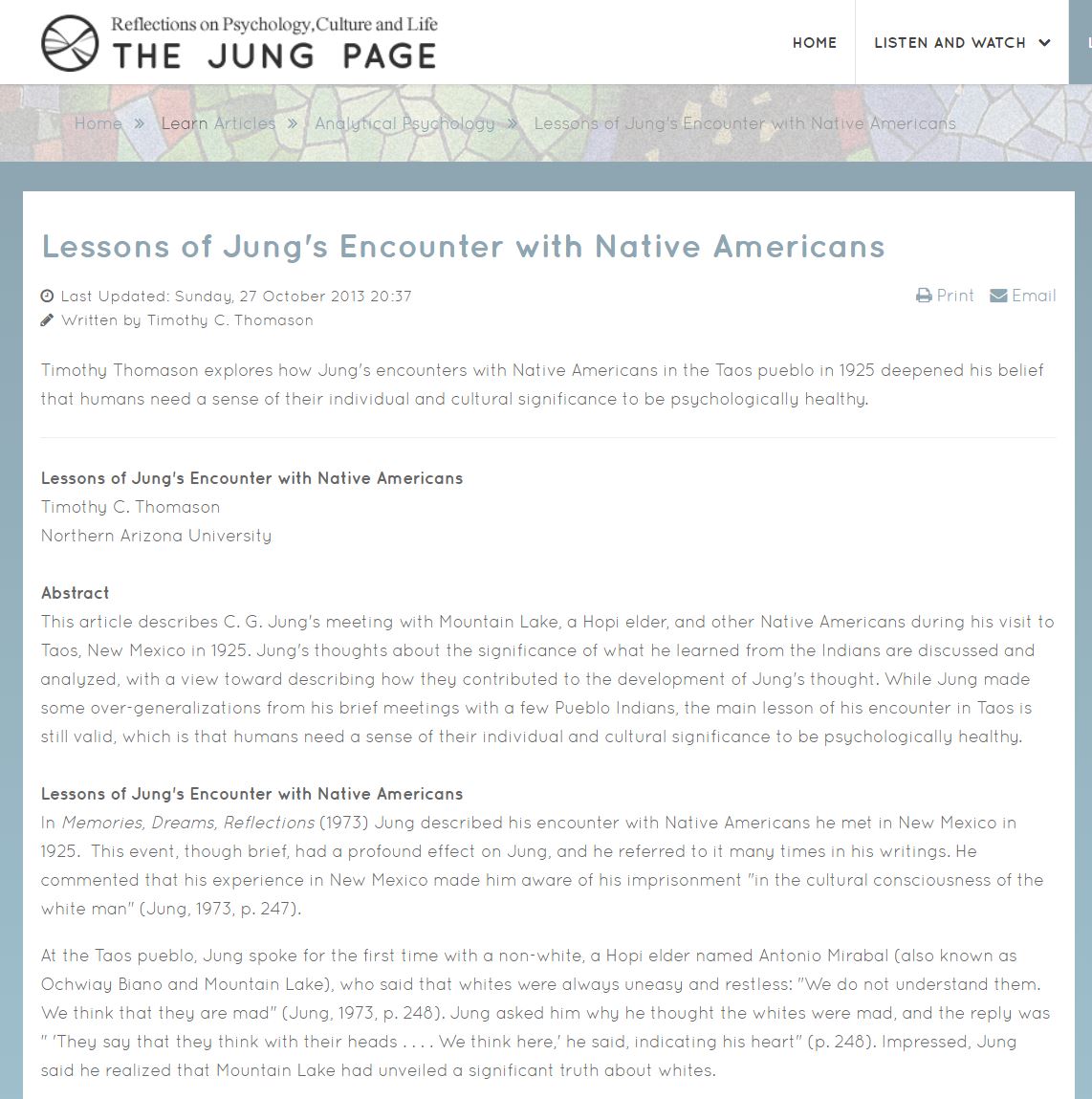Carl Jung and Taos, New Mexico
“What we from our point of view call colonization, missions to the heathen, spread of civilization, etc., has another face the face of a bird of prey seeking with cruel intentness for distant quarry a face worthy of a race of pirates and highwaymen. All the eagles and other predatory creatures that adorn our coats of arms seem to me apt psychological representatives of our true nature.”
Memories, Dreams, and Reflections – unpublished manual
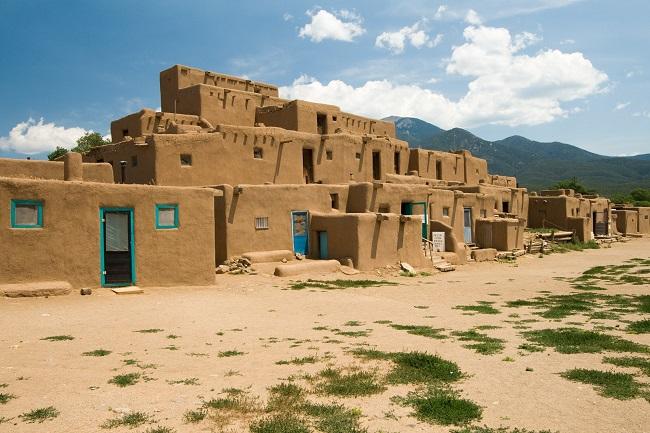
January 5, 1925
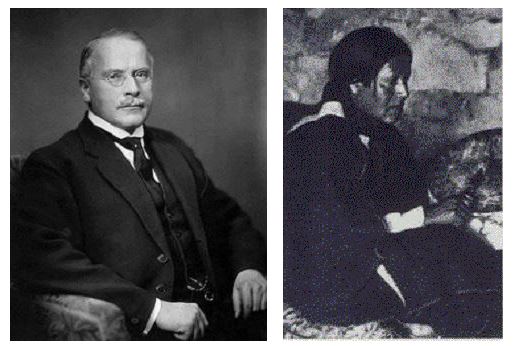
Carl Jung and Hopi elder named Antonio Mirabal (also known as Ochwiay Biano and Mountain Lake)
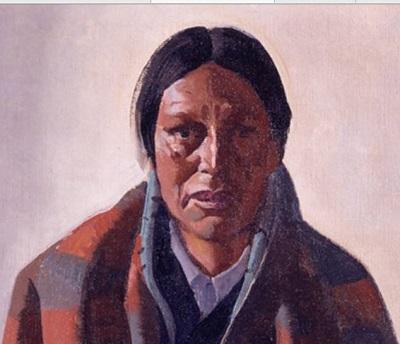
Maynard Dixon, Antonio Mirabal, 1931, Oil on canvas. California Academy of Sciences
***
“Mirabal talked openly about how he felt about white culture, starting with his perception of the features of the white man: thin lips, sharp noses, and cruel dispositions, giving them the appearance of birds of prey. White people were restless, Mirabal said, as they were searching for what they couldn’t find. “We do not understand them. We think they are mad” he told Jung, adding that “whites believed they thought with their heads,” when everyone at the Pueblo knew thinking comes from the heart”.”
***
Taos Valley News (Taos, New Mexico) – January 10, 1925
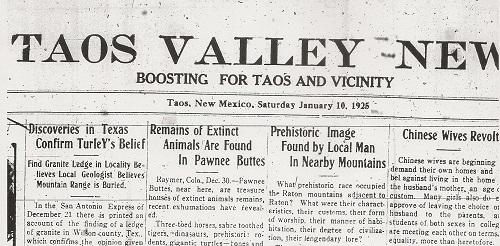
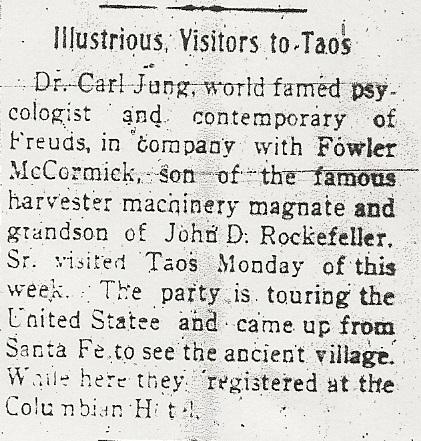
Sat., Jan, 10, 1925, headed “Illustrious Visitors to Taos”: “Dr. Carl Jung, world famed psychologist and contemporary of Freud, in company with Fowler McCormick, son of the famous harvester machinery magnate and grandson of John D. Rockefeller, Sr. visited Taos Monday of this week. The party is touring the United States and came up from Santa Fe to see the ancient village. While here they registered at the Columbian Hotel.”
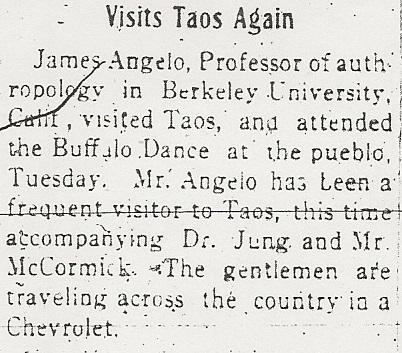
In the same issue, headed “Visits Taos Again”: “James Angelo [Jaime de Angulo – Jaime de Angulo, [student of Indian languages-1925 ], professor of anthropology in Berkeley University, Calif., visited Taos and attended the Buffalo Dance at the pueblo Tuesday. Mr. Angelo has been a frequent visitor to Taos, this time accompanying Dr. Jung and Mr. McCormick. The gendemen are traveling across the country in a Chevrolet.”
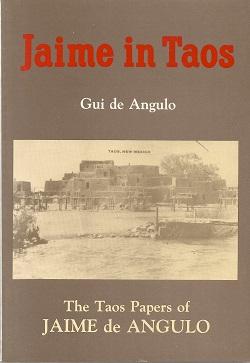
The following is from ‘Jaime in Taos’, Compiled by Gui de Angulo – The Taos Papers of Jaime de Angulo
Carl Jung was brought to Taos, New Mexico by Jaime de Angulo. Jung wrote Jaime and they met at the Grand Canyon in Arizona. The following is from a letter from Jaime de Angulo to Mabel Dodge Luhan.
Jaime returned to Taos in January of 1925. He describes the trip in the following letter sent to Mabel Dodge Luhan, who was in New York being analyzed.
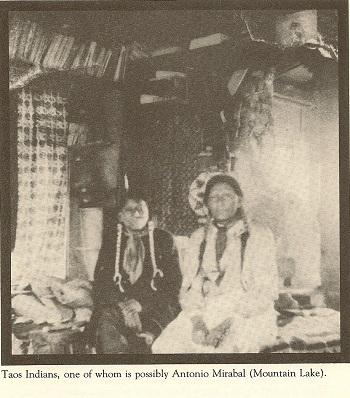
Mabel,
These were two very sweet letters you sent us. We should have answered long ago, but you know how it is with us and no servants, and all the spare time we can scrape devoted religiously to writing up the grammar of the Taos language. We are collaborating on it, N. and I.
Well, by this time you must have heard from Tony an account of my suddenly appearing in Taos with Jung. It was all very sudden. It seems that he decided out of a clear sky to cross over to America for the sake of a little vacation on the steamer. Then the first thing I knew there was a telegram asking me to come and meet him at the Grand Canyon “no expense to you. ” I recognised the generous hand of Mr. Porter (of Chicago). The telegram mentioned the possibility of visiting an Indian Pueblo.
You can imagine my excitement. I made up my mind that I would kidnap him if necessary and take him to Taos. It was quite a fight because his time was so limited, but I finally carried it. And he was not sorry that he went. It was a revelation to him, the whole thing. Of course, I had prepared Mountain Lake (Antonio Mirabal)*. He and Jung made contact immediately and had a long talk on religion. Jung said that I was perfectly right in all that I intuited about their psychological condition. He said that evening “I had the extraordinary sensation that I was talking to an Egyptian priest of the fifteenth century before Christ. ” The trip was an immense success all around. Jung got a great deal out of it. I got a great deal out of Jung, both about philosophy and about my own work. I needed his confirmation of all the stuff I have been working out by my own lonely self and against all anthropological precedent. And I got Porter and young McCormick interested in the Indian question. They realized my thesis: the white American must preserve the Indian, not as a matter of justice or even of brotherly charity, but in order to save his own neck. The European can always tie back to his own mother soil and find therein the spiritual pabulum necessary to life. But the American, overburdened with material culture, is threatened with self-destruction unless he can find some way to tie himself to his own mother soil. The Indian holds that key.
They saw my thesis, and they solemnly promised me that they would not forget it but would use their energy and their influence towards some sort of steady campaign. Maybe they will, maybe they won’t. Maybe the dream of my life is on its way!
What news of Clarence? and of Lawrence?
J-
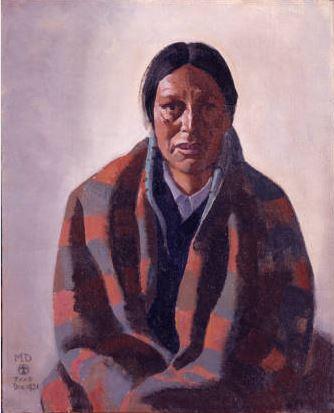
Maynard Dixon, Antonio Mirabal, 1931, Oil on canvas. California Academy of Sciences.
*Mountain Lake was the Indian with whom Jaime had studied the Taos language.
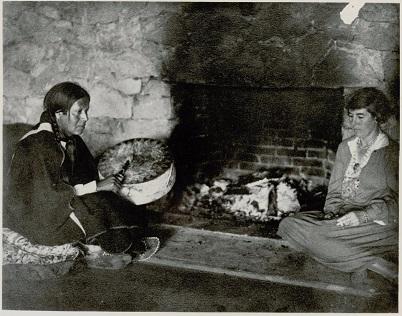
Mountain Lake and Mary Lake Collier, 1926
C.G. Jung in Taos: A Creative Mis-Encounter
David Barton, June 2014
In his book-length conversation on The Red Book, James Hillman suggests two directions out of the box of modern thinking: ‘moving up to erudition or moving down to the indigenous’ (187). Erudition describes some, but not all, of C.G. Jung’s work: the elaborate footnotes, rambling digressions, un-translated Greek phrases, and obscure references. As Hillman suggests, this ‘upward’ movement, this movement into erudition, can be an attempt to free ourselves from reductionism, from the flattening of the world created by the analytical mind. Erudition complicates the world, reveling in its complexities and casting us back into the ‘strangeness’ of ideas, into the timeless dialogues, the unresolved and unresolvable questions that form the seminal fountainhead of the Western tradition (188).
Despite these flights of erudition, Jung is perhaps better characterized by a move in the other direction, the falling ‘down into the indigenous,’ the preposition down suggesting both a value judgment and a return to an older cosmology. Down signifies lower, less developed, the childhood of the historical past that is (ambivalently) experienced as ‘primitive’ on the one hand and rejuvenating on the other. Although this pull downwards is found throughout Jung’s work, I want to focus on the contact with indigenous people, the first being Antonio Mirabal, whom Jung called Mountain Lake. As others have suggested, the meeting with Mirabal was a pivotal moment in Jung’s life, a touchstone, but it was also a mis-Encounter, one that still carries a great deal of unrealized potential.
Jung’s first meeting with indigenous culture occurred in January of 1925. Steam-shipping to America at the request of Edith and Harold McCormick, his American benefactors, Jung arrived in New York City on December 22 for a three-week whirl-wind tour of Chicago, Louisiana, and the American Southwest. At the Grande Canyon he was joined by a gang of Californians, including the brilliant Jaime de Angulo, an anthropologist Jung had been attempting to cultivate. De Angulo later renounced all things Jungian, but at the time he was still both an avid enthusiast and sharp-tongued critic, telling Jung in letters that he and Freud were ‘wrong from beginning to end’ when it came to understanding indigenous people (de Angulo, Coyote, 173). Jung delighted in the critical exchanges, offering to fund some of de Angulo’s anthropological research. From the Grande Canyon, the two drove cross country with Fowler McCormick, the grandson of John D. Rockefeller, Sr., arriving in Taos on January 5, 1925, where they attended a Buffalo dance (Taos News). They appear to have spent two weeks in Northern New Mexico, and de Angulo arranged for Jung to have at least two conversations with Antonio Mirabal, the Taos Indian who had been helping de Angulo build a written lexicon of the Tiwa language. Neither Jung nor any of his biographers noted the delicious irony that Jung bunked at the Columbus Hotel, just as he had crossed the Atlantic on a ship named The Columbus. I suspect Jung didn’t note the irony because was still only dimly aware Colonial underpinnings of many of his ideas, nor did he yet appreciate the animosity Native Americans felt towards the man who brought Europeans to America.
From a charitable point of view, Jung’s burning desire to visit an Indian reservation should be seen as a heroic attempt to witness indigenous people on their own terms, but much of what he learned in his two days at Taos was simply wrong. On personal level, however, the trip proved vital. Standing on the fifth floor of the Taos Pueblo, he conversed to Antonio Mirabal ‘as he had rarely been able to talk with a European.’ As they looked across the Taos plateau, his acquaintance wrapped in a woolen blanket to guard against the winter frost, Mirabal spoke of Father Sun, who provided life, and of the sacred mountain, from which all life came, and of the importance of the kiva rituals which helped Sun cross the sky, telling Jung that ‘If we were to cease practicing our religion, in ten years the sun would no longer rise’ (Jung, MDR, 246-253).
In another passage reported by Jung, Mirabal talked openly about how he felt about ‘white’ culture, starting with his perception of the features of the white man: thin lips, sharp noses, and cruel dispositions, giving them the appearance of birds of prey. White people were restless, Mirabal said, as they were searching for what they couldn’t find. ‘We do not understand them. We think they are mad’ he told Jung, adding that ‘whites believed they thought with their heads,’ when everyone at the Pueblo knew thinking comes from the heart (Jung, MDR, 247-248).
““We think here,” he said, indicating his heart. I fell into a long meditation. For the first time in my life, so it seemed to me, someone had drawn for me a picture of the real white man. It was as though until now I had seen nothing but sentimental, prettified color prints. This Indian had struck our vulnerable spot, unveiled a truth to which we are blind.”
Memories, Dreams, and Reflections – unpublished manual
Such statements should have been in no way shocking to someone who was already reading and thinking about indigenous people, but the comments appear to have been directed personally at Jung, as a man who still thought with his head and who was certainly searching for something he couldn’t find. Whatever the case, Jung fell into a deep meditation, one that has been described not only as a moment of profound ’emotional and psychological confrontation’ with himself but as an oceanic meeting of the world that verged on a participation mystique that had previously been ascribed to ‘primitives’ (Bernstein).
We may never fully understand the communion that Jung felt with Mirabal, but it’s hard to believe that he didn’t associate those conversations with those he had been having in The Red Book for more than 10 years, or with his Big Dream of 1913, in which he colluded ‘with a brown-skin savage man’ to assassinate the Germanic hero Siegfried, with whom Jung identified (MDR 180). Almost ten years later, in a letter he wrote to Mirabal, Jung was still attempting to understand his experience, asking Mirabal (somewhat inappropriately) to reveal the secrets of the kiva. ‘Any information you can give me about your religious life is always welcome to me,’ Jung wrote. ‘I shall keep all that information to myself, but it is most helpful to me, as I am busy exploring the truth in which Indians believe. It always impressed me as a great truth, but one hears so little about it, and particularly over here, where there are no Indians.’ He added, somewhat ruefully, that he could find ‘no interesting religious things’ in Europe, ‘only the remnants of old things’ that no longer carried vitality (Letters, 20-21).
The tragedy is that Jung got so much wrong, and his misunderstandings have been repeated by most of those who have written about his trip to Taos. Mirabal was not an Indian chief, nor did he hold any office in the tribe, and he almost certainly wasn’t a Hopi elder, as he was a relatively young man who had never lived at Hopi. His Indian name was not Ochwiay Biano, as Jung reported, (that name is missing the proper Tiwa suffixes), and Jung mischaracterized the English translation of his Indian name as Mountain Lake, perhaps as a result of a simplification made by Mirabal himself (the actual name being more complicated, suggesting one who is on the way to a pilgrimage at a body of water, probably Blue Lake, a sacred site on Taos Mountain). Finally, Mirabal was not the simple, isolated Indian that Jung imagined but an intelligent, well-travelled impresario who had become an intimate friend of D.H. Lawrence. Within a few years Mirabal would become a national political force in Indian relations, refusing an invitation to meet with President Herbert Hoover, whom he despised, and later travelling to New York to advise Franklin Roosevelt on Indian policy (Sheboygan Press).
Mirabal was also a intimate friend of Tony Lujan and his wife, Mabel Lujan Dodge, one of the most influential arts patron of the early 20th century. Having lived in Florance, New York, and Santa Barbara, Dodge relocated to Taos to found a literary colony that was dedicated to the rejuvenation of Western society. It was Dodge who brought D.H. Lawrence to Taos, as well as Jaime de Angulo, scheming behind the scenes to bring Jung as well. It was in a letter to Dodge that de Angulo had written that ‘the white man must preserve the Indian, not as a matter of justice or brotherly charity, but in order to save his own neck’ (Rednick 185), a sentiment which Dodge shared completely. D.H. Lawrence shared the vision as well, writing that in New Mexico, living among the Indians, he rediscovered ‘the ancient race self and religious self’ that had long been eradicated in Europe (Lawrence 16). For both Lawrence and Dodge, the union between white culture and Indian culture would create a new kind of society.
It’s important to remember, then, that Jung’s encounter with Mirabal was marinated in these long-running ideas, not least because Mirabal was a daily visitor at the Dodge house. While Jung imagined himself having an innocent conversation with his first ‘primitive,’ he was unwittingly entering into the remnants of an extraordinary attempt by artists, intellectuals, and Indians to build a new consciousness involving both European and indigenous sensibilities. De Angulo himself had been a frequent visitor to the Dodge house, and he must have discussed the unique atmosphere in Taos on their long, cross-country drive. If not, Jung clearly intuited the relationship between what he found in Taos and his own work.
Given the importance of the visit for Jung, including the recollections in his autobiography, I’m left wondering why so little has been written on the subject. Why haven’t we known, for instance, about what Jung got wrong? Given Jung’s own inclinations, I’m also stunned that there has been no sustained, in-depth dialogue between the Jungian community and indigenous people. Surely one part of the answer lies in the difficulty of such a project, given the shadow of colonization, the issues of distrust, guilt, anger, and betrayal that make dialogue difficult. But not just that: such a project is ultimately a creative risk, an invitation into the impossibility involved in simultaneously entertaining two incompatible ideas, or cultures, a dis-orientation that requires (temporarily and psychologically) leaving behind the certainty that any discipline or body of work provides.
Thankfully, events in the last few years have re-awakened such possibilities. I am thinking, for instance, of the increasing number of Native Americans who have shown an interest in Jung, including students, scholars, and psychologists, as well as Analytical Psychologists, principally Jerome Bernstein, who have done the hard work of listening to Native American traditions on their own terms. To my mind the most important development has been the publication in 2006 of the first full-length study of Jung by a Native American, a book that has gone largely unrecognized in the world of Analytical Psychology, although not in the Indian world, where the author, Vine Deloria, is a legendary figure. C.G. Jung and the Sioux Traditions is an extra-ordinary book in many ways, opening a entire new field of study, one combining but the upwards flight of erudition and the descent into indigenous life. The book is equal measures appreciation and critique of Jung, whom Deloria looks upon with love and horror. From Deloria’s indigenous perspective, Jung gets much wrong but also provides the only psychological system capable of communicating the wisdom of American Indian culture to the Western psyche (Bernstein xi). Deloria returned to this manuscript again and again in the last two decades of his life, much as Jung returned to The Red Book for two decades, repeating, clarifying, reworking, exorcising his compulsive need to get it right.
As for myself, I teach both Deloria and Jung side by side in an upper-division seminar for interdisciplinary students in psychology and the humanities. I can report that students are fascinated by the conflict between Deloria and Jung, as if they understand instinctively that the imbalance and friction between the two of them is related to an unseen harmony, some future prospect that they can often feel but can’t articulate. About two-thirds of the undergraduate students I’ve worked with identify with Deloria and his Native American sensibilities, rather than Jung, a fact that suggests the creative possibility still exists.
Work Cited
Berenstein, Jerome. Forward. C.G. Jung and the Siuux Traditions: Dreams, Visions, Nature, and the Primitive by Vine Deloira, Jr.. New Orleans: Spring Journal Books, 2006.
De Angulo, Gui. Jaime in Taos: The Taos Papers of Jaime de Angulo. San Francisco: City Lights P, 1985.
De Angulo, Gui. The Old Coyote of Big Sur: The Life of Jaime de Angulo. Berkeley: Stonegarden P, 1995.
Deloria, Jr., Vine. C.G. Jung and the Sioux Traditions: Dreams, Visions, Nature, and the Primitive. New Orleans: Spring Journal Books, 2006.
Hillman, James and Sonu Shamdasani. Lament of the Dead: Psychology after Jungs Redbook. New York: W.W. Norton, 2013.
Jung, C.G. Ed. Gerhard Adler. Selected Letters of C.G. Jung, 1909-1961. Princeton: Princeton UP, 1984.
Jung, C.G. Trans. Richard and Clara Winston. Memories, Dream, Reflections. Princeton: Princeton UP, 1963.
Lawrence, D.H., New Mexico. Originally written in 1928. Republished in New Mexico Magazine, July 1997, pages 12-20.
Rudnick, Lois Palken. Mabel Dodge Luhan: New Woman, New Worlds. Albuqeurque: UNM Press, 1984.
Sheboygan Press, Jan. 26, 1933, (page number?).
The Taos News, unnamed author, Jan. 10, 1925, 1.
Lessons of Jung’s Encounter with Native Americans
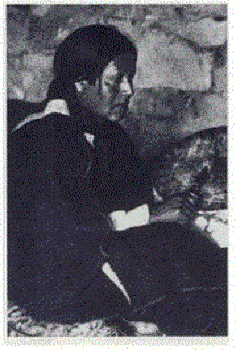
Ochwiay Biano
In Memories, Dreams, Reflections (1973) Jung described his encounter with Native Americans he met in New Mexico in 1925. This event, though brief, had a profound effect on Jung, and he referred to it many times in his writings. He commented that his experience in New Mexico made him aware of his imprisonment “in the cultural consciousness of the white man” (Jung, 1973, p. 247).
At the Taos pueblo, Jung spoke for the first time with a non-white, a Hopi elder named Antonio Mirabal (also known as Ochwiay Biano and Mountain Lake), who said that whites were always uneasy and restless: “We do not understand them. We think that they are mad” (Jung, 1973, p. 248). Jung asked him why he thought the whites were mad, and the reply was ” ‘They say that they think with their heads . . . . We think here,’ he said, indicating his heart” (p. 248). Impressed, Jung said he realized that Mountain Lake had unveiled a significant truth about whites.
To Jung the Indians he met appeared to be tranquil and dignified, which Jung attributed to their belief that (as Mountain Lake explained) through their religious practice, they helped the sun cross the sky every day. Jung believed this belief and practice served the function of making the Indians’ lives cosmologically meaningful. Whites, on the other hand, use reason to formulate the meaning of life: “Knowledge does not enrich us; it removes us more and more from the mythic world in which we were once at home by right of birth” (Jung, 1973, p. 252). Jung said that it would be necessary to put away all European rationalism and knowledge of the world to begin to understand the Pueblo Indian’s point of view.
Jung pointed out that “The idea, absurd to us, that a ritual act can magically affect the sun is, upon closer examination, no less irrational” than the Christian religion which, like every religion, is “permeated by the idea that special acts or a special kind of action can influence god – for example, through certain rites or prayers” (Jung, 1973, p. 253). Jung said that while the cosmological beliefs of the pueblo dwellers would be seen as superstitious by Europeans, to the Native Americans European beliefs about science would be seen as superstitious and illogical (Jung, 1964). To Mountain Lake, it was obvious than that the sun provides all light and all life and is therefore the great father or God. Jung, on the other hand, argued that God is the one who created the sun. Jung realized that from a modern perspective, Mountain Lake’s animism and Christianity are equally superstitious.
Jung attributed the dignity and serenity of the Pueblo Indians to their relationship to the deity, and their belief that their rituals were essential to keep the universe functioning (Berger & Segaller, 2000). Jung interpreted Mountain Lake’s reference to the restlessness of whites as describing their “insatiable lust to lord it in every land,” and their megalomania “which leads us to suppose that Christianity is the only truth” (Jung, 1933, p. 213). In Jung’s view, the religious and cosmological beliefs of all cultures are useful to help people make their existence seem meaningful.
The main lesson Jung learned from his encounter with Mountain Lake was the importance of forging meaning through a coherent system of beliefs and practice. The content of the belief system is secondary; since philosophical and religious beliefs are based on faith and cannot be empirically validated, in a sense one system is as good as another. Each culture or subculture has their own system of beliefs and practices that provide a sense of meaning. Such belief systems need not be religious; even an agnostic or atheist worldview provides the individual with a view of existence that makes sense to that individual.
Jung was interested in developing a theory of how Pueblo psychology might complement his theory of personality types (Bair, 2003). Jung’s visit with Mountain Lake (who he called his “Red Indian friend” (Jung, 1933, p. 213)) prompted him to think about how different cultures value thinking and feeling differently, just as individuals within a culture do. Based on Mountain Lake’s comment that Indians think with their hearts rather than their heads, Jung speculated that there is a great divide between whites and Indians, and he seemed to admire the Indian psychology.
Jung’s theory of psychological types has been compared to the circular sand paintings of the Navajo, which symbolize the mythical history of the gods, the ancestors and mankind (Sandner, 1991). Duran (1995) graphically represented the four Jungian personality types on two axes (north/thinking; east/sensation; south/feeling; and west/intuition. Others have placed the types in different positions on a circle (north/sensation; east/thinking; south/intuition; and west/feeling (Moodley & West, 2005). Which type goes with which compass point is, apparently, not important, as long as thinking is opposite feeling and sensation is opposite intuition. Two additional psychological functions of introversion and extraversion could be visualized as being above and below the center of the circle. For an individual, the goal is to walk in balance at the center of the sphere (Duran, 2006).
Duran (1984) criticized Jung for his overly idealized view of Native Americans, specifically Jung’s (1964) comment that the Indians were so at ease that they were unaware that they were living in America (under the domination of the whites). Jung did not see that many Indian people felt so oppressed that they were drinking themselves to death, according to Duran (1984).
Jung saw the lives of the Indians he met as simple and serene, even though their serenity was based on what Jung considered an animistic mythological system. Jung’s view of the Indians as serene and tranquil may be considered as stereotyping to some degree. Many Europeans and European-Americans have seen the aboriginal Indian people as “noble savages,” as if their lack of advanced technology somehow made them inherently noble. A more reasoned view would be that Indian people are people like any others, and have both positive and negative aspects. The apparent simplicity and tranquility of the Pueblo dwellers impressed Jung, but in his brief one-day visit he apparently was not made aware of the many social problems that were, and still are, common in many Indian communities. A longer visit may have revealed some distress beneath the tranquility. In addition, if, as Jung concluded, all religious and mythological systems are equally irrational, then why idealize one over another? But Jung’s encounter with Mountain Lake did illustrate to Jung how different cultures are similar in their need to make sense of the universe, even if their explanations differ.
Jung may also have over-generalized about the Indians when he tried to compare their thinking style to that of whites. Jung believed that being fully conscious requires intensive thinking, and is exhausting. Primitive people (as he called them) do not think; if they think at all, it is in the belly or in the heart; they are conscious only of emotional thoughts (Jung, 1968). Referring to the Pueblo dwellers, Mountain Lake said they think with their hearts, not their heads. Jung said “the Pueblo Indians derive consciousness from the intensity of feeling. Abstract thought does not exist for them. . . . They cannot go beyond the perceptions of their senses and their feelings” (Jung, 1968, p. 9).
Jung’s interest in Indian psychology is admirable, although today it is apparent that his generalizations about Indian psychology were simplistic and based on very little information. His only Indian informant on psychology was Mountain Lake, who only talked with Jung for part of one day and told Jung generalities already known to the general public (Bair, 2003). Jung’s limited understanding of Indian psychology led him to idealize it. Given Jung’s interest in world mythologies and his belief that all such systems are human creations, one might expect him to simply describe the Pueblo dweller’s beliefs as one more belief system, rather than idealize it.
Jung was, of course, correct that the Pueblo belief system was sophisticated enough to serve as a meaning-making system for the Indian people who believed in it. He said “Primitive psychology is by no means primitive” (Jung, 1968, p. 9). Jung actually found his own ideas more in tune with the Pueblo Indians than with the culture of early twentieth-century Europe. “He saw that it was quite wrong to believe that the white man had all the truths” (Berger & Segaller, 2000, p. 152). Jung wrote “it is not only primitive man whose psychology is archaic. It is the psychology also of modern civilized man . . . . every civilized human being, however high his conscious development, is still an archaic man at the deeper levels of his psyche” (Jung, 1964, p. 50-51). This thought reinforces the idea that while modern whites might think they know it all, most of them still operate psychologically at a primitive level. For example, many Americans participate fully in their highly technological society while at the same time holding religious beliefs that date back thousands of years.
Jung never forgot his encounter with the Indians in New Mexico. In a letter to Mountain Lake several years after his visit, Jung said “I am busy exploring the truth in which Indians believe. It always impressed me as a great truth” (quoted in Berger & Segaller, 2000, p. 137). One lesson of Jung’s encounter with Mountain Lake is that all humans need a belief system to make sense of the universe, even if every culture has a different belief system, and there is no way to know which (if any) belief system is correct. Jung seemed to feel that it really does not matter which system is believed, since the effect (a sense of meaning) in each case is the same.
Just a year before he died, Jung said that Mountain Lake correctly assumed that the consciousness and meaning of his people “will die when destroyed by the narrow-mindedness of American rationalism” (quoted in Berger & Segaller, 2000, p. 153). From this comment it appears that Jung felt that American society as a whole emphasized the thinking function to the exclusion of the feeling function. In Jungian analysis, an individual who was unbalanced in this way would be encouraged to experiment with getting more in touch with his or her feeling side (Duran, 2006).
There are interesting similarities between Jung’s theories and Native American healing. Sandner (1991) suggested that the traditional symbolic healing rituals of the Navajo operate on the same principles as modern psychotherapy, which is also a symbolic form of healing. While almost all forms of psychotherapy operate on a symbolic level, Jung’s analytical psychology is perhaps the approach that most explicitly recognizes the symbolic and mythological dimensions of the human personality. Like the ritual healing ceremonies of Native Americans, psychotherapy is a socially sanctioned ritual that involves its own belief system. While modern psychotherapies like to claim their practices are empirically supported, often the reference to science is just a pro forma part of the ritual. In modern healing practices, science tends to have more credibility to patients than ancient ceremonies, but scientific practices are not necessarily more effective for healing psychological distress.
It has been noted that Jung’s view of the goal of psychotherapy as achieving balance and integration of the parts of the self is similar to the goal of traditional Native American healing rituals. After studying the ceremonies of the Navajo for many years, Donald Sandner noted that “If you wanted a place to look for corroboration of a lot of Jung’s views . . . you could do no better than to look into the Navajo symbol system – it’s all there. It’s all put together from the collective unconscious” (quoted in Berger & Segaller, 2000, p. 141). Joseph Henderson said “The Indian’s ceremonies come from the rightful use of archetypes in the unconscious” (quoted in Berger & Segaller, 2000, p. 144). It may be that the widespread belief that humans have disparate aspects that must be integrated into a whole to be healthy provides support for Jung’s concept of the collective unconscious.
C. G. Jung’s encounter with Mountain Lake in New Mexico was a provocative meeting that Jung always remembered with fondness. He felt that he learned important lessons about how Indian people think, and about the relativism and utility of belief systems. Mountain Lake’s perspective on the meaning of existence made clear to Jung that all humans would benefit by having a clear (but humble) sense of their own significance in the order of things.
Source:
Lessons of Jung’s Encounter with Native Americans, Timothy C. Thomason
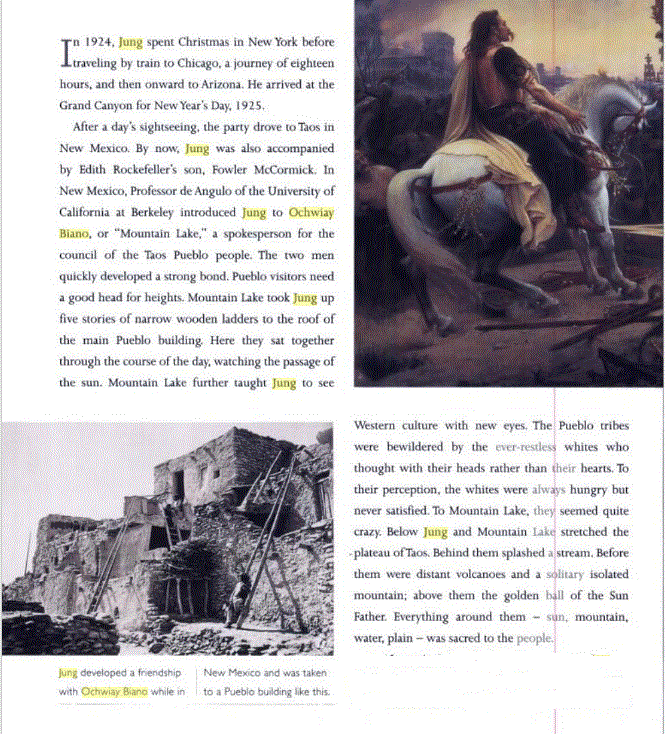
The following is from Bridge to Oneness
Carl Jung’s experience in New Mexico with the Pueblos Indians
Posted on April 20, 2012
MEMORIES, DREAMS, REFLECTIONS BY C.G. JUNG
In this long passage, there are two distinct but yet related stories. One is about how the Pueblos see the white man who has colonized them and is about to destroy their ancient culture. The second story goes into the mysteries of Indians ways of relating to nature and in particular the sun: ‘After all’ he said, ‘we are a people who live on the roof of the world; we are the sons of the Father Sun, and with our religion we daily help our father to go across the sky. We do this not only for ourselves, but for the whole world. If we were to cease practising our religion, in ten years time the sun would no longer rise. Then it would be night forever.’
Please let me know how you feel and what you think about this passage!
On my next trip to the United States, I went with a group of American friends to visit the Indians of New Mexico, the city-building Pueblos. ‘City,’ however, is too strong a word. What they build are in reality only villages; but their crowded houses piled one atop the other suggest the word ‘city,’ as do their language and their whole manner. There for the first time I had the good fortune to talk with a non-European, that is, to a non-white. He was the chief of the Taos Pueblos, an intelligent man between the ages of forty and fifty. His name was Ochwiay Bianco (Mountain Lake). I was able to talk with him as I have rarely been able to talk with a European. To be sure, he was caught up in his world just as much as a European is caught up in his, but what a world it was! In talk with a European, one is constantly running up on the sandbars of things long known but never understood; with this Indian, the vessel floated freely on deep, alien seas. At the same time, one never knows which is more enjoyable: catching sight of new shores, or discovering new approaches to age-old knowledge that has been almost forgotten.
‘See,’ Ochwiay Bianco said, ‘how cruel the whites look. Their lips are thin, their noses sharp, their faces furrowed and distorted by folds. Their eyes have a staring expression; they are always seeking something. What are they seeking? The whites always want something; they are always uneasy and restless. We do not know what they want. We do not understand them. We think they are mad.’
I asked him why he thought the whites were all mad.
‘They say they think with their heads,’ he replied.
‘Why of course. What do you think with,’ I asked him in surprise.
‘We think here,’ he said, indicating his heart.
I fell into a long meditation. For the first time in my life, as it seemed to me, someone had drawn for me a picture of the real white man. It was as though until now I had seen nothing but sentimental, prettified colour prints. This Indian had struck our vulnerable spot, unveiled a truth to which we are blind. I felt rising within me like a shapeless mist something unknown and yet deeply familiar. And out of this mist, image upon image detached itself: first Roman legions smashing into the cities of Gaul, and the keenly incised features of Julius Caesar, Scipio Africanus, and Pompey. I saw the Roman eagle on the North Sea and on the banks of the White Nile. Then I saw St. Augustine transmitting the Christian creed to the Britons on the tips of Roman lances, and Charlemagne’s most glorious forced conversions of the heathen; then the pillaging and murdering bands of the Crusading armies. With a severe stab I realised the hollowness of that old romanticism about the Crusades. Then followed Columbus, Cortes, and the other conquistadors who with fire, sword, torture and Christianity came down upon even these remote Pueblos dreaming peacefully in the Sun, their Father. I saw, too, the peoples of the Pacific islands decimated by firewater, syphilis, and scarlet fever carried in the clothes the missionaries forced on them.
It was enough. What we from our point of view call colonisation, missions to the heathen, spread of civilisation, etc., has another face ‘the face of a bird of prey seeking with cruel intentness for distant quarry’ a face worthy of a race of pirates and highwaymen. All the eagles and other predatory creatures that adorn our coats of arms seem to me apt psychological representatives of our true nature.
Something else that Ochwiay Bianco said to me stuck in my mind. It seems to me so intimately connected with the peculiar atmosphere of our interview that my account would be incomplete if I failed to mention it. Our conversation took place on the fifth story of the main building. At frequent intervals figures of other Indians could be seen on the roofs, wrapped in their woollen blankets, sunk in contemplation of the wandering sun that daily rose in a clear sky. Around us were grouped the low-built square buildings of air-dried brick (adobe), with the characteristic ladders that reach from the ground to the roof, or from roof to roof of the higher stories. (In earlier, dangerous times the entrance used to be through the roof.) Before us the rolling plateau of Taos (about eleven thousand feet above sea level) stretched to the horizon, where several conical peaks (ancient volcanoes) rose to over twelve thousand feet. Behind us a clear stream purled past the houses, and on its opposite bank stood a second pueblo of reddish adobe houses, built one atop the other towards the centre of the settlement, thus strangely anticipating the perspective of an American metropolis with its skyscrapers in the centre. Perhaps half an hour’s journey upriver rose a mighty isolated mountain, the mountain, which has no name. The story goes that on days when the mountain is wrapped in cloud, the men vanish to perform mysterious rites.
The Pueblo Indians are unusually closemouthed, and in matters of their religion utterly inaccessible. They make it a policy to keep their religious practices a secret, and this secret is so strictly guarded that I abandoned as hopeless any attempt at direct questioning. Never before had I run into such an atmosphere of secrecy; the religions of civilised nations to-day are all accessible; their sacraments have long ago ceased to be mysteries. Here, however, the air was filled with a secret known to all the communicants, but to which whites could gain no access. This strange situation gave me an inkling of Eleusia, whose secret was known to one nation and yet never betrayed. I understood what Pausanias or Heredotus felt when he wrote: ‘I am not permitted to name the name of that god.’ This was not, I felt, mystification, but a vital mystery whose betrayal might bring about the downfall of the community as well as of the individual. Preservation of the secret gives the Pueblo Indian pride and the power to resist the dominant whites. It gives him cohesion and unity; and I feel sure that the Pueblos as an individual community will continue to exist as long as their mysteries are not desecrated.
It was astonishing to me to see how the Indian’s emotions change when he speaks of his religious ideas. In ordinary life he shows a degree of self-control and dignity that borders on fatalistic equanimity. But when he speaks of things that pertain to his mysteries, he is in the grip of a surprising emotion which he cannot conceal a fact which greatly helped to satisfy my curiosity. As I have said, direct questioning led to nothing. When, therefore, I wanted to know about essential matters, I made tentative remarks and observed my interlocutor’s expression for those affective movements which are so very familiar to me. If I had hit on something essential, he remained silent or gave an evasive reply, but with all the signs of profound emotion; frequently tears would fill his eyes. Their religious theories are not conceptions to them (which, indeed, would have to be very curious theories to evoke tears from a man), but facts, as important and moving as the corresponding external realities.
As I sat with Ochwiay Bianco on the roof, the blazing sun rising higher and higher, he said, pointing to the sun, ‘Is not he who moves there our father? How can anyone say differently? How can there be another god? Nothing can be without the sun.’ His excitement, which was already perceptible, mounted still higher: he struggled for words, and exclaimed at last, ‘What would a man do alone in the mountains? He cannot even build his fire without him.’
I asked him whether he did not think the sun might be a fiery ball shaped by an invisible god. My question did not even arouse astonishment, let alone anger. Obviously it touched nothing within him; he did not even think my question stupid. It merely left him cold. I had the feeling that I had come upon an insurmountable wall. His only rely was, The sun is God. Everyone can see that.
Although no one can help feeling the tremendous impress of the sun, it was a novel and deeply affecting experience for me to see these mature, dignified men in the grip of an overmastering emotion when they spoke of it.
Another time I stood by the river and looked up at the mountains, which rise almost another six thousand feet above the plateau. I was just thinking that this was the roof of the American continent, and that the people lived here in the face of the sun like the Indians who stood wrapped in blankets on the highest roofs of the pueblo, mute and absorbed in the sight of the sun. Suddenly a deep voice, vibrant with suppressed emotion, spoke from behind me into my left ear: Do you think that all life comes from the mountain? An elderly Indian had come up to me, inaudible in his moccasins, and has asked me this heaven knows how far-reaching question. A glance at the river pouring down from the mountain showed me the outward image that had engendered this conclusion. Obviously all life came from the mountain, for where there is water, there is life. Nothing could be more obvious. In his question I felt a swelling emotion connected with the word mountain, and thought of the tale of secret rites celebrated on the mountain. I replied, “Everyone can see that you speak the truth.”
Unfortunately, the conversation was soon interrupted, and so I did not succeed in attaining any deeper insight into the symbolism of water and mountain.
I observed that the Pueblos Indians, reluctant as they were to speak about anything concerning their religion, talked with great readiness and intensity about their relations with the Americans. “Why”, Mountain Lake said, “do the Americans not let us alone? Why do they want to forbid our dances? Why do they make difficulties when we want to take our young people from school in order to lad them in the kiva (site of the rituals, and instruct them in our religion? We do nothing to harm the Americans!” After a prolonged silence, he continued, “The Americans want to stamp out our religion. Why can they not let us alone? What we do, we do not only for ourselves but for the Americans also. Yes, we do it for the whole world. Everyone benefits by it.”
I could observe from his excitement that he was alluding to some extremely important element of his religion. I therefore asked him: “You think, then, that what you do in your religion benefits the whole world?” He replied with great animation. “Of course. If we did not do it, what would become of the world?” And with a significant gesture he pointed to the sun.
I felt that we were approaching extremely delicate ground here, verging on the mysteries of the tribe. “After all,” he said, “we are a people who live on the roof of the world; we are the sons of the Father Sun, and with our religion we daily help our father to go across the sky. We do this not only for ourselves, but for the whole world. If we were to cease practising our religion, in ten years time the sun would no longer rise. Then it would be night forever.”
I then realised on what the dignity, the tranquil composure of the individual Indian, was founded. It springs from his being a son of the sun; his life is cosmologically meaningful, for he helps the father and preserver of all life in his daily rise and descent. If we set against this our own self-justifications, the meaning of our own lives as it is formulated by our reason, we cannot help but see our poverty. Out of sheer envy we are obliged to smile at the Indians naiveté and to plume ourselves on our cleverness; for otherwise we would discover how impoverished and down at the heels we are. Knowledge does not enrich us; it removes us more and more from the mythic world in which we were once at home by right of birth.
The following is from Elayne Wareing Fitzpatrick’s Traveling Backward, 2009.

JAIME DE ANGULO
ON SAVING OUR OWN NECKS
[Talk given at the Jeffers Studies Conference in Taos, N.M., April, 2001]
My offering this morning is an introduction to Big Sur’s brightest and quirkiest outlander, Dr. Jaime de Angulo. Like Robinson Jeffers and D. H. Lawrence, he was lured to Taos by the irrepressible Mabel Dodge Luhan. Henry Miller, his neighbor in Big Sur, gave the most compelling description of him.
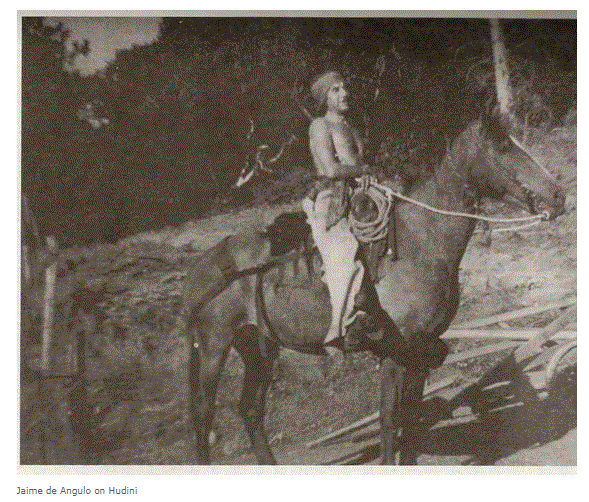
He was “definitely the outlaw,” Miller wrote, “a renegade and a reprobate, [a] savage, scholar, man of the world, recluse, idealist, and the very son of Lucifer … a beloved . . . detested, endearing, charming, cantankerous, pesky, devil-worshipping son-of-a-bitch of a man with a proud heart and a defiant soul, [yet] filled with tenderness and compassion for all humanity. . . dear Jaime de Angulo!”
De Angulo incurred the jealousy of Lawrence whom he read approvingly and didn’t like personally. But he did like Jeffers, felt a deep kinship with the poet, without ever reading Jeffers’ words. He was lauded by William Carlos Williams as one of the most outstanding writers he had ever encountered and by Ezra Pound who dubbed him the American Ovid.
Background: De Angulo was a Basqueman, born in Paris to aristocratic Spanish expatriates. He was also a disappointed Catholic idealist, renegade from a rigid Jesuit education, who had expected to experience a sublime transformation during confirmation. He left Paris in 1905 with some inheritance money-and sailed to America, hoping to make living as a rancher.
Like Lawrence, he was always on quest. HIS PASSIONATE DESIRE WAS TO HAVE HIS OWN EXPERIENCE OF LIFE AND GOD. He found the uncorrupted religion he sought-a way to “get at” God-in the pre-Christian primal vitality of our American Indians and spent the rest of his life trying to convince the rest of us that this earth does not belong to us. Quite the contrary. His view was that we belong to the landscape and that’d we’d better respect it and take good care of it if we hope to survive.
Along his path of discovery, he worked as a Colorado cowhand and foreman of a road gang in Honduras; helped fight the San Francisco fire after the quake of 1906; won a medical degree from Johns Hopkins and a degree in psychiatry from University of Michigan; did genetic research at Stanford; bought a cattle ranch in Alturas; hung out with the Pit River Achumawi Indians; was a maverick professor at UC Berkeley in linguistics, anthropology, psychiatry, astronomy, and mathematics; and an artist/writer who drove a herd of horses some 500 miles to his ranch in Big Sur where he developed dark themes reminiscent of Jeffers and tinged with the lighter touch of Lawrence.
With all this, he managed to introduce Carl Jung, with whom he studied in Zurich, to the Taos Indians, setting the stage for what ultimately came to be known as the Indian Movement in these United States.
Clearly, he was alive one. He quipped somewhere that everything he researched and experienced was just “for the fun of creating.”
Impatient with solemn’ scholars who refused to be playful, de Angulo, like Lawrence, had great fun going forth in search of God, following, as Lawrence put it, “the Holy Ghost and depending on the Holy Ghost” within him.
Yet he was serious in his scholarship. He had a genius for languages and a passionate interest in the psychology of the primitive mind.
Not only did he record Indian languages and myths, including his own subjective impressions in the field, he wrote deep, sometimes surreal, novels. They were thought adventures, like those of Lawrence, that seemed to come from the blood, not just from the mind.
One of his best, The Lariat, was about a missionary whose passion was to convert the wild Esselen Indians to Catholicism. The padre in the tale saw Big Sur as a villainous landscape to be tamed. But to the novel’s protagonist-a Spanish deserter who married an Indian woman and had “gone back wild”-it was a beautiful and sacred place.
He was also a great teller of stories about a prehistoric dawn when animals and men in the mountains and plains of this continent weren’t as easily distinguished from each other as they are today. He called these stories, Indian Tales, and read them to children over KPFA in Berkeley. It became the most popular program in the station’s history. My own grandchildren love the stories and want me to read them over and over again.
De Angulo described the lives of his Indians as “a continuous religious experience.” He marveled at what he called their “spirit of wonder, the recognition of life as power, as a mysterious, ubiquitous, concentrated form of nonmaterial energy, of something loose about the world and contained in a more or less condensed degree by every object.”
But he wasn’t always so mystical. After befriending the Achumawis in Northern California, he returned to these people, time and again, for sustenance, just as he returned to wilderness of Big Sur.
He said the Indians accepted him because he was Spanish, which, to them, meant “Mexican,” They considered him “one of us.” Especially when he would drink with them.
His overt enthusiasm for their gambling games, their songs, and their “savage” ways nettled his peers at Berkeley. They admired his work, but they also protested, “Decent anthropologists don’t associate with drunkards who go rolling in ditches with shamans.”
There’s no question that de Angulo was quite off-the-wall at times, as many of you who have read Melba Bennett’s biography of Jeffers know. She couldn’t resist repeating a story about the man-the one where he and the Jefferse’s meet for the first time on the Carmel beach. Una, of course, was impressed by his swashbuckling good looks. He was tall, slender, dressed like a Spanish vaquero, and walked proudly in the company of two Irish wolfhounds.
It was she who persuaded Robin to accept de Angulo’s impromptu invitation to come to his Carmel cabin and share the Porterhouse steaks he was carrying under his arm, probably meant for the dogs. Jaime grilled the meat to perfection. But when the time came to eat, he had second thoughts and tossed it to the wolfhounds.
Why? “It would be a shame” he said, “for them to go hungry.”
The Jefferse’s seemed to have no problem with this. Perhaps, on getting to know this man better, they realized that he held an Indian belief that animals possess older powers superior to our own and ought to be treated with respect-which could have meant, in this case, that one doesn’t give steaks meant for good dogs to strangers.
Far from being put off by this incident, Una gushed about Jaime and his wife, a “hen medic” who graduated with Jaime from Johns Hopkins:
“We have the most wildly interesting new friends… I could go on interminably about them.”
She described Jaime as having a commission in the medical corps, playing the flute and oriental pipes, writing Chinese, drawing “clever caricatures,” and caring “for nothing but living alone far from cities” on a homesteaded ranch in Big Sur.
But all this isn’t what makes Jaime de Angulo important to the theme of this conference.
HIS IMPORTANCE HERE LIES IN THE STARTLING THESIS OF HIS LIFE’S WORK:
“The white American must preserve the Indian, not as a matter of justice or even of brotherly charity, but in order to save his own neck. The European can always tie back to his own mother soil and find therein the spiritual pabulum necessary to life. But the American, overburdened with material culture, is threatened with self-destruction unless he can find some way to tie himself to his own mother soil. The Indian holds that key. “
De Angulo believed that we Whites must ultimately recognize what the Red Man knows intuitively-that the landscape itself is sacred, that it embodies divinity and shares it with all nature-from stones, plants, animals, to human beings and, as Jeffers would put it, to “the mouse in the wall.”
This, of course, is a concept de Angulo shared with other writers we’re discussing at this conference. Not only Jeffers, but Edward Abbey-who was a desert Jeffers-and Lawrence whom Mabel hoped Jeffers would replace in her Taos circle.
In Lorenzo in Taos, the book she addressed to Jeffers to lure him here, Mabel described her first encounter with de Angulo while she and her Indian husband, Tony, were visiting in Mill Valley:
“One day when Tony and I were lying on the grass outside our house, we heard a shout and a loud ‘Hallooo!’ We turned and saw a queer fellow coming along to us. He was wearing a long cape, his shirt was open at the neck, and a blue beret clung to the back of his head. He said
his name was Jaime de Angulo and that he had heard there was an Indian living on Tamalpais, so he’d walked over from Berkeley to look for him. So began our acquaintance with Jaime! It was he who told me all about Jung, with whom he had been working in Zurich.”
I was particularly intrigued by Mabel’s reference to Jung because I had met a medicine man in Taos years ago who told me that if I hoped to understand the religion of the Indian, as well as the wisdom of Lawrence, perhaps even Jeffers, I should read Carl Jung.
The Luhan’s persuaded de Angulo to drive back to Taos with them to meet Lawrence. Mabel was enthusiastic about his Jungianism and believed that Lawrence would share that enthusiasm.
She described Jaime as being prepared “to worship Lawrence as a hero.” When the two men met, however, she was disappointed.
“[Jaime],” She said, “attempted to please in the very way Lawrence couldn’t endure!”
For example, Mabel wrote: “Lawrence himself was outspoken enough … but he didn’t like other people to be so; particularly he disliked uncouth language from other men. So when Jaime called women bitches, Lorenzo just squirmed. And when Jaime tore off his shirt in the dining-room one day after lunch and strutted up and down, showing what fine muscles he had in his back, Lorenzo looked quite pale and sick and ran out of the room.”
When the group came together at Manby Hot Springs north of Taos, everyone was delighted by Jaime’s theatrics.
Everyone but Lawrence.
According to Mabel, as soon as Jaime entered the hot springs environs he had cried, “I recognize the Power-the Collective Unconscious!” Then he closed his eyes, stretched himself out, and started to recite Indian prayers.
Lawrence was indignant: “A man has no business to be so indecent in a nice hot spring like that.”
He left in a huff.
It wasn’t long before de Angulo tired of the great man’s disdain. He simply passed it off by saying that Lawrence was “ridiculous, as only an Englishman can be!” Then he turned his attention to Lawrence’s wife who didn’t mind at all.
Mabel wrote: “One night after supper . . . Lawrence jumped up from his chair and ran up to Frieda, who was joking with Jaime … he began to shout invectives at her, calling her a bitch and so on. The next day he told me Lawrence was a red fox, and that, after all, Frieda was much the more important of the two, much more of a person. ‘[He said] none of you people around here appreciate her. You’re all hypnotized by Lawrence. He’s nothing but a neurotic!”‘
‘ After that, de Angulo stopped trying to impress Lawrence the man and began to compete with Lawrence the writer. Mabel noted that “he produced pounds and pounds of paper, and arranged a writing-table in the wide window of the log cabin … in plain view of everyone coming or going. There he sat [writing] all day long for days.”
De Angulo didn’t stay long on that first trip to Taos in 1924. But he was to return, shortly, for some meaty encounters with the Indians.
In a letter to his wife about the pending trip, he admitted: “I don’t intend to work-just loaf. I may never find anything of interest to my special line of research among the Pueblo Indians. I feel that they are too civilized, almost as much as the Aztecs, or the early Greeks. My Indians are the California tribes, real primitives with the ‘wonder stuff loose and free on tap. Still you can’t tell. Deep in my heart there is an ambition that I may be able to reach that group of old men, the Keepers of the Faith … I feel it in my bones that they know a great deal about the translation of certain powerful elemental forces into safe symbols.”
He did get to those Keepers of the Faith, thanks to Tony Luhan. Tony took a liking to Jaime, just as he would take a liking to Jeffers in 1930. In fact he liked Jaime, trusted him so much that he broke with his rule of ignoring white men who were curious about Indian secrets. He not only put de Angulo in touch with Antonio Mirabal, the Indian known as Mountain Lake, he introduced him to other important Pueblo elders.
Late in 1925, both the Pueblos and de Angulo would benefit from Tony’s decision. De Angulo wrote to Mabel about a trip to Taos with Carl Jung:
“You can imagine my excitement. I made up my mind that I would kidnap [Jung] if necessary and take him to Taos. [When we arrived] it was a revelation to him, the whole thing. Of course I had prepared Mountain Lake. He and Jung made contact immediately and had a long talk on religion.
“Jung said that I was perfectly right in all that I intuited about their psychological condition … The trip was an immense success all around. Jung got a great deal out of it. I got a great deal out of Jung, both about philosophy and about my own work. I needed his confirmation of all the stuff. I have been working out by my own lonely self and against all anthropological precedent.
“I got [the Americans who accompanied us] interested in the Indian question. They saw my thesis … and they solemnly promised me that they would not forget it but would use their energy and their influence towards some sort of steady campaign … Maybe the dream of my life is on its way!”
Jung himself would write, after the trip with de Angulo, “1 was able to talk with [Mountain Lake] as I have rarely been able to talk with a European [and discovered] new approaches to age-old knowledge that has been almost forgotten.”
He told how the Indian had complained, “[Whites] are always uneasy and restless. We do not understand them. We think that they are mad. They say that they think with their heads.”
“Why of course,” dung answered. “What do you think with?”
“We think here,” Mountain Lake replied, indicating his heart, and his eyes filled with tears.
After a long silence, he continued, “The Americans want to stamp out our religion. Why can they not let us alone? What we do, we do not only for ourselves but for the Americans also. Yes, we do it for the whole world. Everyone benefits by it.” Jung asked how.
The Indian explained that the Pueblos are a people who live on the roof of the world, nearest to God and the sky. So they are quite specially “the sons of Father Sun.” With their religion, he said, Indians help their Father go across the sky. Everything is interconnected, he reminded. To maintain balance, the Great Spirit needs humans to do their part.
“We do [ceremonies] not only for ourselves,” Mountain Lake explained, “but for the whole world. If we were to cease practicing our religion, in ten years the sun would no longer rise. Then it would be night forever.”
“I then realized,” Jung wrote, “on what the ‘dignity,’ the tranquil composure of the individual Indian, was founded. It springs from his being a son of the sun; his life is cosmologically meaningful, for he helps the father and preserver of all life in his daily rise and descent.
“If we set against this our own self-justification, the meaning of our own lives as it is formulated by our reason, we cannot help but see our poverty. Out of sheer envy we are obliged to smile at the Indians’ naivete and to plume ourselves on our cleverness . . . knowledge does not enrich us; it removes us more and more from the mythic world in which we were once at home by right of birth. “
He pointed out that the Christian religion “is [also] permeated by the idea that special acts or a special kind of action can influence God-for example, through certain rites or by prayer, or by a morality pleasing to the Divinity… Our [Christian] prayers are all directed to asking favors of God; the Indian has far more dignity, for he thinks with his heart and wishes to give as well as receive.”
The Indians, he said, speak a mythological language, much nearer to the primal vitality, the archetypal world of the unconscious. “The decisive question for man,” he wrote, “is: ‘Am I related to something infinite or not?”‘
The Indian not only has this relationship, Jung concluded, he has all the dignity and peace of soul which it brings.
Then he shared an incident that occurred as he stood alone, looking up at the Pueblos’ sacred mountain. An old Indian materialized noiselessly beside him and’asked “in a deep voice vibrant with emotion… “Do you not think that all life comes from the mountain?”‘
Jung interpreted this as a synchronistic message and answered: “Everyone can see that you speak the truth.”
When Jung came to America he couldn’t help noticing what he called the “Indianizing” of whites who had settled on this foreign-to-them soil.
On returning to Switzerland, he made use of Jaime’s thesis-that white Americans must preserve the Indian “in order to save our own necks.”
He even went so far as to warn his students that when they analyze an American about his shadow, they must be much more careful than when they analyze a European.
Why?
“[Because] when the American opens a . .. door in his psychology, there is a dangerous open gap, dropping hundreds of feet, and in those cases where he can negotiate the drop, he will then be faced with an Indian … shadow, whereas [it is safer for the European to open the door because he] finds a shadow of his own race.”
One result of Jung’s trip to Taos was that he joined the ranks of all the prophetic voices who have understood the importance of Indian symbols and rites, as well as the necessity of convincing white Americans that our own religions must eventually relate back to the earth, that the sacred landscape must dominate and structure our culture, not the other way around, if we are to survive our own population explosions and uprooted technological cleverness.
Back in 1909, when, Jung accompanied Freud to America to receive honorary doctorates from Clark University, he made a telling comment in a letter to his wife:
“We have seen things here that inspire enthusiastic admiration, and things that make one ponder social evolution deeply. As far as technological culture is concerned, we lag miles behind America. But all that is frightfully costly and already carries the germ of the .find in itself. “
This, when the rest of the world was looking forward to an era of unprecedented social and economic progress. Jung, like Jeffers, was already in touch with the primal shadow that stalks all human enlightenment.
Visiting Taos on his second trip to America, Jung became as convinced as any Indian that the sacred Blue Lake area must be restored to the people of the Taos Pueblo, if only to avert environmental catastrophe.
The Blue Lake controversy encapsulated the whole distinction between Indians and non-Indians, a distinction spelled out so clearly in the now-famous letter sent by Chief Seattle to the Great “White Chief” in Washington which, I know, most of you have read.
The Department of Agriculture fought hard to retain the Blue Lake area’s valuable timber for future industrial profit. But in 1970, President Nixon signed the bill to get their Blue Lake shrine returned to the Taos people. The bill also guaranteed that Indian religious practices would be given equal respect along with Christian ceremonies.
This happened after a five-year groundswell among grass roots Americans moved by their admiration for the Indians’ refusal to take money for their sacred ground.
Perhaps it was no accident that the Indian Movement of the 1960’s paralleled another grass roots movement in ecology that sparked new interest in Jeffers and prepared the way for Edward Abbey’s controversial book, The Monkey Wrench Gang.
Had they lived to see this, Jung (who died in 1961) and de Angulo (1950) would have been delighted, not only for the Indian’s right to his land and ceremonies, but for the rest of us as well.
In 1925, de Angulo wrote an impassioned letter to Ruth Benedict, assistant to anthropologist Frank Boas, who had sought de Angulo’s help in getting an “informant” to reveal secrets of the Taos Indians:
“Oh, God! Ruth … do you realize that it is just that sort of thing that kills the Indians? I mean it seriously. It kills them spiritually first, and, as in their life the spiritual and the physical element are much more interdependent than in our own stage of culture, they soon die of it physically. They just lie down and die.
“That’s what you anthropologists with your infernal curiosity and your thirst for scientific data bring about… Of course if you promised that you would never publish the actual secrets, I would tell you a lot myself about the meaning of the whole thing. It is all right to talk about it in a general way, with . .. the necessary care that must be always used in handling all esoteric knowledge. It is as powerful and dangerous as the lightning.
“Look at all the harm that raw psychoanalysts do to their patients … But the actual details of ceremonies, that must never be told … You wouldn’t inveigle my child into telling you the secrets of my home.”
Then he spelled out his thesis for her:
“Don’t you see the meaning of it all? In Europe, we can go back to our mother the earth through the spirit of our own ancestors. They inhabit the soil, the trees, the rocks. In America, the soil is teeming with the ghosts of Indians. Americans wil never find spiritual stability until they learn to recognize the Indians as their spiritual ancestors. [But] you would lose [their legacy] by killing the Indian off before that messageas been comprehended by the white Americans. And you kill the Indian as surely by disorganizing his spiritual social life as you do with guns.”
As de Angulo suspected, it would be a natural leap for Jung, dedicated as he was to the God-image in the human psyche, to recognize the Collective Unconscious in the Indian’s concept of the primal source of generative energy underlying cosmic diversity.
Every school child know? it as the “Great Spirit” or “Mighty Something.”
Jamake Highwater calls it “Primal Mind;” the ancient Greeks mythologized it as Pan-power, Alan Watts referred to it as “It,” and Robinson Jeffers saw it as the “divine beauty of the universe.” He simply called it “God.”
Lawrence, yet another fierce advocate for the primal mind, perceived it as “the Holy Ghost within. For him, the primal consciousness of the Indian was akin to what he saw as a pre-mental “blood consciousness” that charges all life. From the standpoint of human ethics, it isn’t always beautiful, as Lawrence knew. But for him, as for the Indians, it was to be trusted, religiously.
He wrote:
“It was a vast old religion, greater than anything we know: more darkly and nakedly religious. There is no God, no conception of a god. All is god. But it is not the pantheism we are accustomed to, which expresses itself as ‘God is everywhere, God is in everything.’ In this Indian religion everything is alive, not supernaturally but naturally alive.”
It should come as no surprise, then, that he was hugging trees, literally, on his Kiowa ranch here. Especially a big pine tree that “rises like a guardian spirit” in front of the cabin where he lived.
Living at the ranch, he had his first “permanent feeling of religion” after questing around the world. He wrote that here in New Mexico “a vast old religion which once swayed the earth lingers in unbroken practice . . . older, perhaps, than anything in the world save Australian aboriginal taboo and totem, and that is not yet religion.”
He wrote:
“I have become conscious of the tree, and of its interpenetration into my life. Long ago, the Indians must have been even more acutely conscious of it, when they blazed it to leave their mark on it. I am conscious that it helps to change me, vitally. I am even conscious that shivers of energy cross my living plasm, from the tree, and I become a degree more like unto the tree, more bristling and turpentiney, in Pan. And the tree gets a certain shade and alertness of my life, within itself.”
He is reminiscent of Jeffers when he describes the “splendid silent terror and vast far-and-wide magnificence” of this place that was “the greatest experience from the outside world that I have ever had … It changed me forever.”
It should be made clear, however, that neither Lawrence nor de Angulo idealized the Indians. Nor did Jeffers: Lawrence rightly observed that, in time, even the Indian “will kill Pan with his own hands, for the sake of a motor car.” But he held out a modicum of hope:
“Whether we are a store-clerk or a bus-conductor we can still choose between the living universe of Pan, and the mechanical conquered universe of modern humanity. The machine has no windows. But even the most mechanized human being has only got his windows nailed up, or bricked in.”
And de Angulo wrote, not without some admiration mingled with affection for his Indians:
“My God, think of it, to pass in one lifetime from the stone ax to wireless telegraphy! Indians in overalls; no, there was nothing picturesque about these Indians, no feather headdresses or beaded moccasins, nothing to delight the tourists about these ‘digger Indians’ in their battered hats and cheap calicos, picking the offal of the whites on the garbage dumps at the edge of town. My Indians in overalls!”
As for Jeffers, who wrote just one poem about his Taos experience, he stopped only a little short of cynicism:
I watch the Indians dancing to help the young
corn
at Taos pueblo, the old men squat in a ring
And make the song, the young women with
fat, bare arms,
and a few shame-faced young men, shuffle
the dance.
The lean-muscled young men are naked to the
narrow loins,
their breasts and backs daubed with white
clay,
Two eagle-feathers plume the black heads.
They dance
with reluctance, they are growing civilized;
the –
old men persuade them.
Only the drum is confident, it thinks the world
has not
changed; the beating heart, the simplest of
rhythms,
It thinks the world has not changed at all;
it is only
a dreamer, a brainless heart, the drum has
no eyes.
These tourists have eyes, the hundred watching
the dance, white Americans, hungrily too,
with reverence, not laughter;
Pilgrims from civilization, anxiously seeking
beauty,
religion, poetry; pilgrims from the vacuum.
People from cities, anxious to be human
again.
Poor show how they suck you empty! The
Indians are emptied,
And certainly there was never religion
enough,
nor beauty nor poetry here-to fill Americans.
Only the drum is confident, it thinks the
world has
not changed. Apparently only myself and the
strong
that civilization is a transient sickness.
The tribal drum, and the rock head of Taos mountain,
Remember.
De Angulo may have been disappointed that he wasn’t able to connect personally with Lawrence, but he did connect deeply with Jeffers, who was his alter ego. Yes, they shared common interests. They even spoke to each other in French and debated the merits of ancient and modem Greek pronunciation. More often, however, they absorbed each other’s energy, a little like Lawrence’s interaction with his pine tree.
Evidence?
When the Robinson Jeffers supplement to ‘The Carmelite’ was published in Carmel in 1928, de Angulo was asked about his friendship with Jeffers. I want to close this paper with his reply because I like it. It’s so child-like, so primal.:
“I couldn’t tell you anything about Jeffers. That man is a mystery to me and has always been. I don’t know what he is thinking about, or how he thinks, as I have never read any of his books … I like him because he is GOOD-looking. He never talked with me. I did all the talking. I don’t know whether he ever understood a word of what I said. But that didn’t matter.
“On the contrary, that was the beauty of it; to talk to a man, and to know that he is not listening to your words. It’s like carrying on a conversation with yourself. You talk and talk and say anything you feel like saying without any regard for the contradictions, and all the while you have a feeling that the fellow is thinking about something else, something inside of him.
“You are perhaps walking with him along the road by the beach. There is the stunted chaparral, and the sand, the beach, the breakers booming. We both see all that. I talk. He is dreaming away. The stunted chaparral, the breakers, the glistening sand colour my talk. They colour his dreaming. Somehow or other his dreaming gets inside of me and my words get inside of him.
“He built himself a house, with his own hands-enormous boulders, mortar, half of cement, walls as;thick as half the. room inside. Why did he do it? He doesn’t know himself. But I could tell him. It was all for the sake of that little window, that tiny little window upstairs where you lie on your stomach and peep at the stormy sea outside!”
***
More on Jaime DeAngulo
Theo Radich – “Jaime de Angulo was born in Paris of Spanish parents…”
